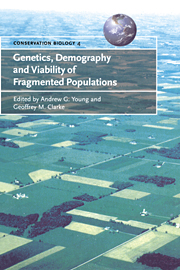Book contents
- Frontmatter
- Contents
- List of contributors
- Foreword by Peter F. Brussard
- Preface
- 1 Introduction: genetics, demography and the conservation of fragmented populations
- Part I Introductory concepts
- 2 Managing and monitoring genetic erosion
- 3 Inbreeding and outbreeding depression in fragmented populations
- 4 Demography and extinction in small populations
- 5 The metapopulation paradigm: a fragmented view of conservation biology
- 6 Population viability analysis for conservation: the good, the bad and the undescribed
- 7 Applications of population genetics and molecular techniques to conservation biology
- Part II Animal case studies
- Part III Plant case studies
- References
- Index
6 - Population viability analysis for conservation: the good, the bad and the undescribed
Published online by Cambridge University Press: 29 January 2010
- Frontmatter
- Contents
- List of contributors
- Foreword by Peter F. Brussard
- Preface
- 1 Introduction: genetics, demography and the conservation of fragmented populations
- Part I Introductory concepts
- 2 Managing and monitoring genetic erosion
- 3 Inbreeding and outbreeding depression in fragmented populations
- 4 Demography and extinction in small populations
- 5 The metapopulation paradigm: a fragmented view of conservation biology
- 6 Population viability analysis for conservation: the good, the bad and the undescribed
- 7 Applications of population genetics and molecular techniques to conservation biology
- Part II Animal case studies
- Part III Plant case studies
- References
- Index
Summary
ABSTRACT
Population viability analysis (PVA) is used in a variety of ways to solve conservation problems. These uses are defined in part by data availability and theoretical and biological understanding, and in part by social, regulatory and political context. The use of a PVA in one context does not preclude or invalidate its use in another. In this paper we attempt to discuss objectively the role of PVA in population management and conservation planning. We emphasise its role in organising information, engaging stake-holders, and making decisions. To be successful, some traditional views about population models and decision-making need to be suspended and reviewed.
INTRODUCTION
The use of population models in conservation biology is at a crossroads. In the 1980s many believed that population viability analysis (PVA) would provide a comprehensive framework for threatened-species management. Early enthusiasm has been tempered by problems with lack of data, lack of validation, and several studies that have demonstrated the sensitivity of results to uncertainty in the data (Taylor, 1995; Ruckelshaus et al., 1997). More and more conservation ecologists are expressing disappointment at the inability of PVA to provide verifiable answers, to be impregnable to misinterpretation or to make the work of an academic conservation ecologist any easier (Doak & Mills, 1994; Beissinger & Westphal, 1998). Others who view PVA from a more applied perspective and have tried to use it to help with environmental legislation, land-use planning and making decisions about the management of populations have also been disappointed (Hamilton & Moller, 1995; Harcourt, 1995).
- Type
- Chapter
- Information
- Genetics, Demography and Viability of Fragmented Populations , pp. 97 - 112Publisher: Cambridge University PressPrint publication year: 2000
- 37
- Cited by

